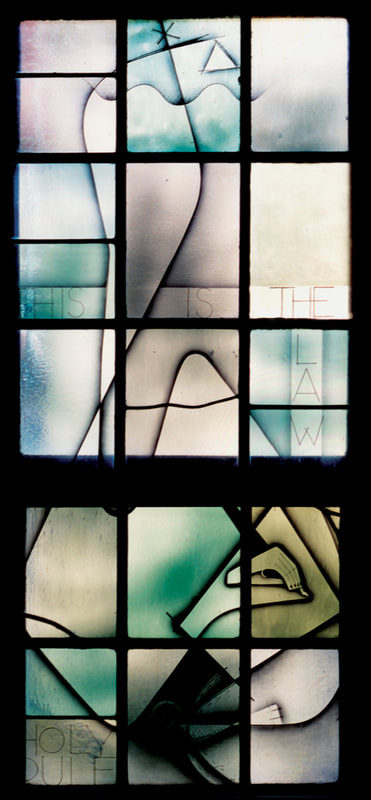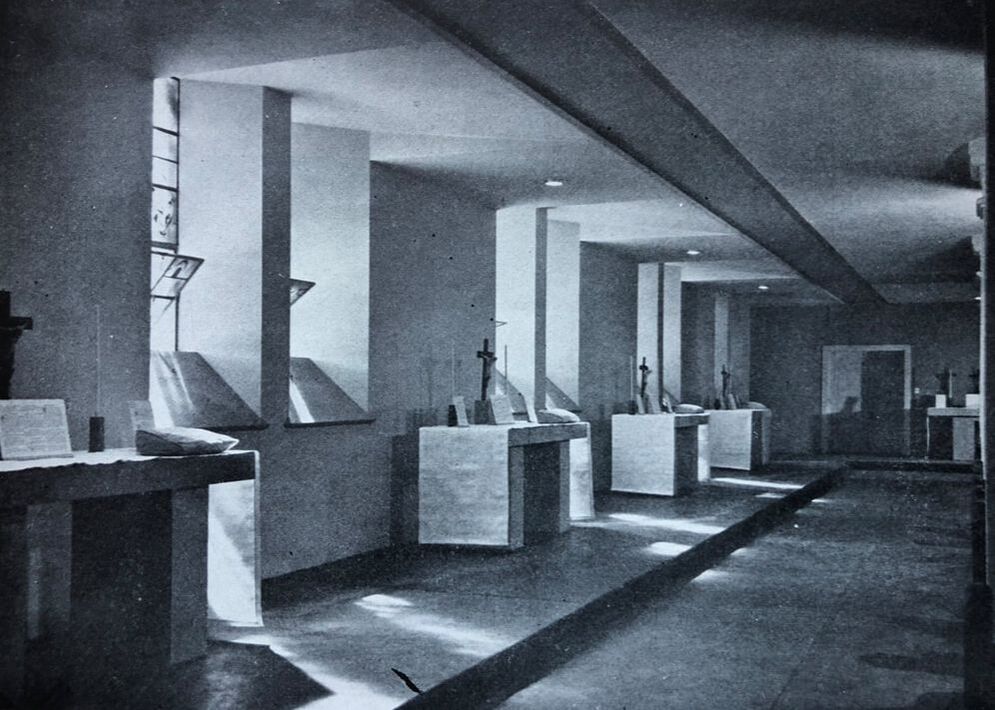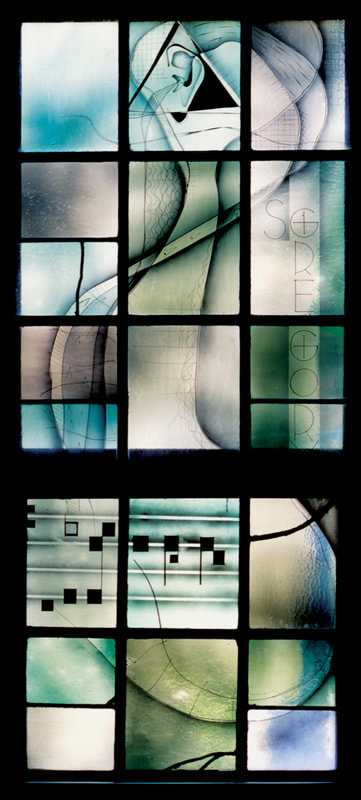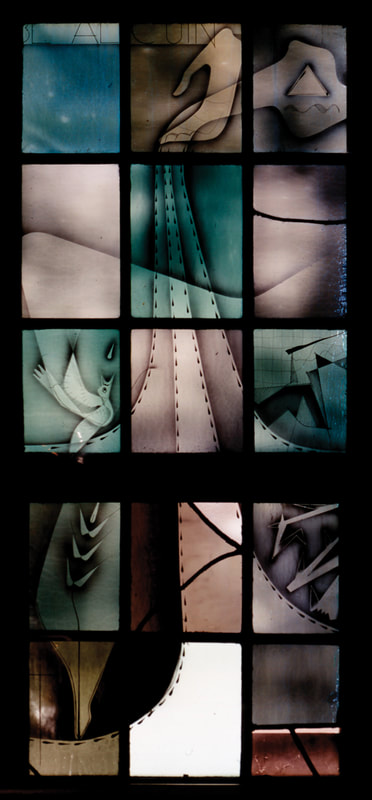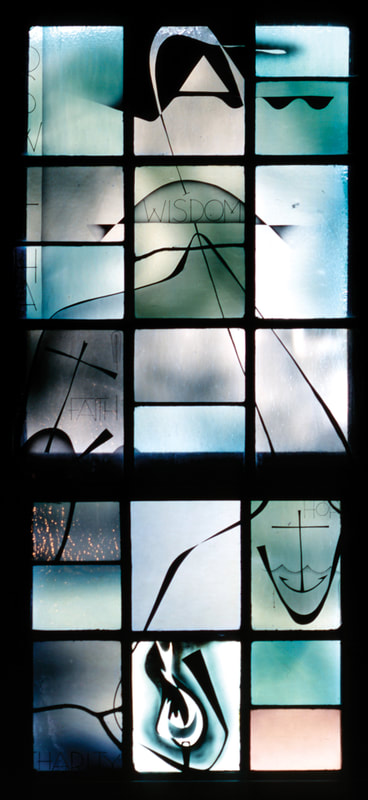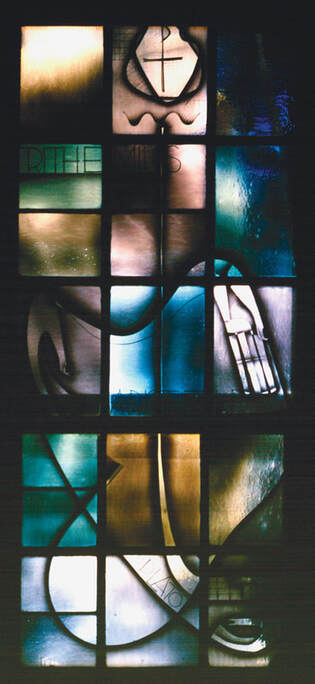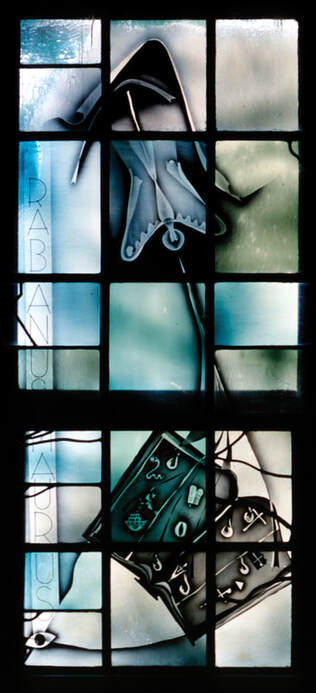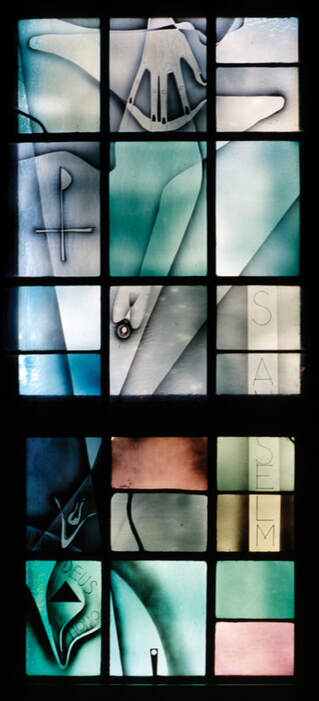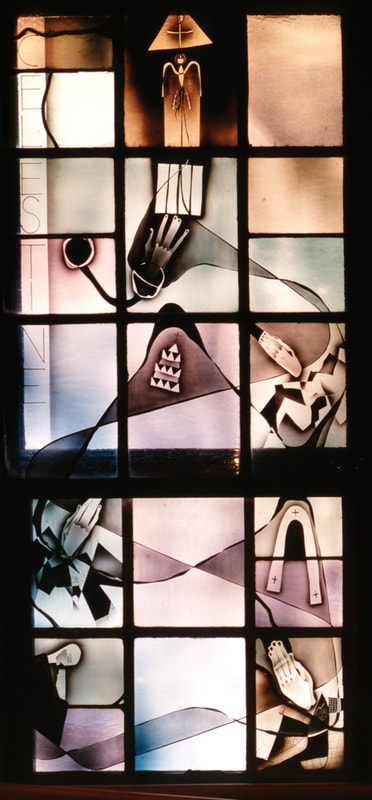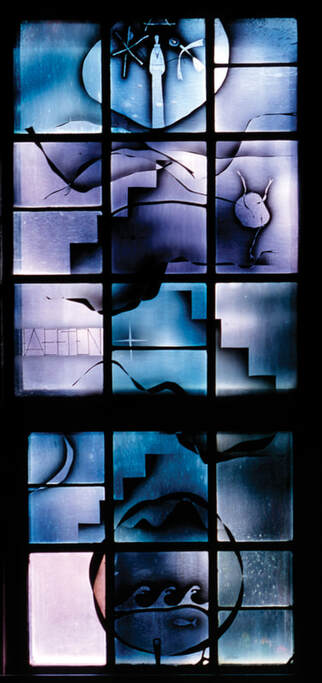|
For over 1500 years, Saint Benedict’s Holy Rule has outlined a monastic rhythm of life marked by periods of communal and private prayer, labor, sleep, and scriptural meditation. Two lines extending from the Chi Rho at the top of the window encircle Saint Benedict’s hand depicted writing the Rule accompanied by a dove, symbolizing the inspiration of the Holy Spirit.
|
Emil Frei Jr. and Robert E. Harmon, Emil Frei Studios, American, 1896–1967, American, 1915–1999, The Holy Rule, 1946, Leaded glass with vitreous paint, 77 x 35 1/2 in. each, Saint Vincent Archabbey Collection. Photo: Kim Metzgar.
Beneath Saint Vincent’s grand Basilica abides the Archabbey’s Crypt–a contemplative space that pays homage to the spiritual lineage of the Benedictine Order. Dedicated to coincide with the Archabbey’s centennial in 1946, the Crypt honors the contributions of the pioneering monks and nuns who introduced the Benedictine way of life to America. Father Quentin Schaut, OSB, was responsible for organizing the project and commissioned Emil Frei Studios of Saint Louis, Missouri to create the stained-glass windows that magnify the space. Emil Frei, Jr. and Robert E. Harmon were responsible for the windows’ design.
|
Saint Vincent Archabbey Basilica Crypt, ca. 1949. Photo: Saint Vincent Art & Heritage Collections Archive.
|
Light filters through leaded glass that illumines the space in a vast array of aural green, cerulean, gray, and violet. Initially, plans called for a triptych to adorn each of the ten altars representative of the filial abbeys founded by Saint Vincent; thus, muted tones were chosen for more diffused light. Rather than creating a likeness of the individual, Emil Frei Studios relied on the power of symbols to commemorate sixteen historically significant monastics combined with a virtue or accomplishment each exemplified. Beginning with The Holy Rule (depicted above) authored by Saint Benedict, the windows follow in chronological sequence:
|
|
In addition to authoring the biography of Saint Benedict, the 6th century pope Saint Gregory the Great is credited with developing plain chant, the official music of the Roman Church. Musical notations and winding lines connote songs of praise passing through the ear of God.
Deriving imagery from the Gospel Parable of the Sower, the window references the indelible educational impact made on behalf of the 8th century scholar and abbot of Tours, Blessed Alcuin.
The 10th century medieval Saxon nun named Roswitha developed dramatic performances informed by Christian morality. Imagery for the window comes from her final play, Sapientia, where Faith, Hope, and Charity are personified as the daughters of Wisdom.
It was Peter the Venerable that initiated a reformation of monastic practices during his tenure as abbot of Cluny in the 12th century. Figures of kneeling monks illumined by the light of Christ represent the importance of discipline within the life of believers
Among the most important mystics of the 14th century, Saint Gertrude the Great is depicted with hands uplifted to God. The encircling form, tongues of flame, and the Chi Rho all symbolize the intimate union with God experienced by the mystics.
Benedictines have long cherished the humanist thought found in classical literature. The Renaissance era German abbot John Trithemius is symbolized by extended hands passing on Classical knowledge indicated by the names of Aristotle and Plato.
The Enlightenment-era monastic scholar Jean Mabillon outlined scientific procedures for testing the authenticity of documents in his preeminent text, Re De Deplomatica. A cluster of chaotic lines intended to represent falsehoods and forgeries is pierced by the Chi Rho, symbolizing both Christ and Truth.
|
Building remains a fundamental practice for Benedictines. Abbot Saint Benet Biscop is honored for bringing masons from continental Europe to Northern England in the 7th century,
founding the twin abbeys of Wearmouth and Jarrow. Blessed Rhabanus Maurus was a 9th century scholar famed for his commentaries on the Hebrew and Christian testaments. An open book populated by a myriad of Biblical symbols stresses the importance of scripture study.
Acclaimed philosopher and historian, Saint Anselm is revered for his understanding and articulation of dogmatic theology, represented by pictographs emblematic of the triune nature of God.
Elected pope in 1294, Peter Celestine V renounced his position five months later, returning to a life of ascetic solitude. Hands folded in prayer are repeated throughout the window symbolizing Saint Peter Celestine’s ardent faith.
The vision of God affirmingly extends to the poetry of the widely celebrated English poet and monk, John Lydgate. The 15th century text from Lydgate’s Te Deum reads: Te Deum laudamus! To the lord sovereyne we creaturys knowlch the as creatoure.
Stressing the importance of asceticism, 17th century Belgian Benedictine Benedict van Haeften cites Chapter Seven of The Rule, where Saint Benedict describes twelve degrees of humility necessary to be united with the perfect love of God. Ascending stairs culminate in the figure of Haeften encircled by symbols of the Trinity.
Originally a monk of Saint Michael’s Abbey at Metten, Boniface Wimmer is credited with bringing the Benedictine Order to the United States. Symbols of agriculture, building, as well as the arts and sciences testify to the myriad of initiatives initiated under Wimmer’s leadership.
|
